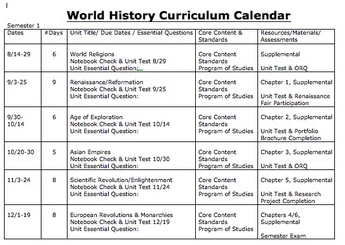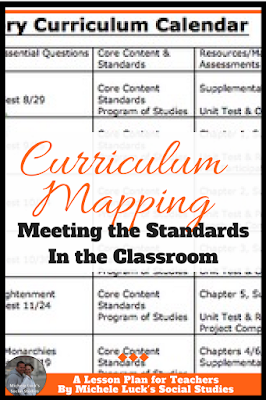One of the most feared responsibilities for new teachers, or even teachers changing courses, is preparing the dreaded curriculum map. In the ole days, we taught with lesson plans, knowing the big picture, but unsure about when we would get there. Most teachers hoped to cover all of their curriculum, but there was no set date and no legal requirements for standard implementation.

With CCSS and newly implemented state standards, as well as school and district requirements, creating a curriculum map is now a must for almost every teacher across the United States. Some schools and districts are even die hard about their mapping, and require all teachers to stay with the map, snow, sleet or storm!
This makes this daunting task even more so.
But it should not be so feared. It is more a challenge in your basic math skills than it is in your ability to lesson plan for your content!
Here are my recommendations for the simple, yet effective curriculum map:
- Start with a simple curriculum map template. It does not need to be pages and pages long, just effective for your personal needs. Try my FREE Curriculum Map Template to get your started.
- Calculate the number of teaching days you will have in the school year. Take your time on this step! Believe it or not, it will be the most challenging. You can start with the number of student days, but you must adjust for testing, final exams, assemblies, field trips, and any other special events that may pull your students from your instruction. Subtracting out these days in your planning will keep you from ending the school year three centuries behind your goal!
- Identify the units you plan to teach. If you are a new teacher, use resources to help you with this task. A textbook Table of Contents can be a valuable tool, or you can utilize my World History or U.S. History Course Bookmarks. At the end of this step, you want a simple number – How many units do I want to teach?
- Divide the number of available days by the number of units. This is your base number of days per unit. Simple, but this doesn’t work for me. Some of my units (my favorites) require far more time than others. And some skills that will be taught require much more attention than others within special units. This must be addressed.
- Begin looking at individual units.
- How much content is involved in the unit?
- What activities do you want to implement?
- Are there special skills you plan to teach?
- Will students need additional time for deeper understanding?
- Are there special topics on which you want to focus?
- Will your assessment/unit project require more time?
- Add days to your larger units, pull from your smaller. Do not worry if some of your units will take 5 weeks, while others may be completed in 1. If you are teaching any subject that is cumulative, you know it will all come back around, and hopefully, come back together in the end.
- Pull out the calendar and begin (with pencil) plotting your units. Again, your math skills will come in handy as you have to maneuver around holidays, special events, etc. I always preferred giving my unit tests or assessments on Fridays, and DEFINITELY before breaks. This will lead to added days in some units and losses in others.
- Begin completing your Curriculum Map Template. Add as much information as you can to this, saving your time later as you will begin unit planning.
- Transfer the start and stop dates from your map.
- Add in test or assessment dates for each unit.
- Write a Unit Title or Brief Description of the unit.
- Identify your essential or BIG question for the unit as a whole.
- Identify the core content, CCSS, and state or district standards you will address by number. Do not add every detail unless required by your district. You can always refer to a standards checklist or the online list for more detail.
- List resources, activities, or projects you plan to utilize. Use this space as a reminder of fun activities you don’t want to forget. Include links to valuable online resources.
- Identify the type of assessment you will use for the unit.
- Work with other teachers, if possible to check that you have everything you need in your map. If you teach the same subjects/courses, see what can be aligned, but do not force this. You are an individual, and your course SHOULD be different from others’ courses. It’s what will help you reach the students in your class that others can’t!
- Save your Curriculum Map EVERYWHERE you may need it for later use in unit and lesson planning. Print a paper copy to hang on your wall or keep in a binder if you prefer to have a visual for highlighting and checklisting.
Final step: Celebrate! The hard part of planning for the year is done! Now you just need to add in all the fun and exciting activities and lessons that will take you from day to day and unit to unit!
Visit my TpT Store for many other teacher tools to help start your school year off on the right foot!

Happy Teaching!